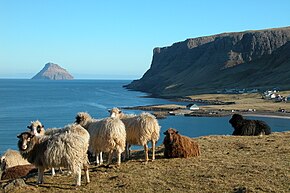
Ecological stoichiometry (more broadly referred to as biological stoichiometry) considers how the balance of energy and elements influences living systems. Similar to chemical stoichiometry, ecological stoichiometry is founded on constraints of mass balance as they apply to organisms and their interactions in ecosystems.[1] Specifically, how does the balance of energy and elements affect and how is this balance affected by organisms and their interactions. Concepts of ecological stoichiometry have a long history in ecology with early references to the constraints of mass balance made by Liebig, Lotka, and Redfield. These earlier concepts have been extended to explicitly link the elemental physiology of organisms to their food web interactions and ecosystem function.[2][3]
Most work in ecological stoichiometry focuses on the interface between an organism and its resources. This interface, whether it is between plants and their nutrient resources or large herbivores and grasses, is often characterized by dramatic differences in the elemental composition of each part. The difference, or mismatch, between the elemental demands of organisms and the elemental composition of resources leads to an elemental imbalance. Consider termites, which have a tissue carbon:nitrogen ratio (C:N) of about 5 yet consume wood with a C:N ratio of 300–1000. Ecological stoichiometry primarily asks:
- why do elemental imbalances arise in nature?
- how is consumer physiology and life-history affected by elemental imbalances? and
- what are the subsequent effects on ecosystem processes?
Elemental imbalances arise for a number of physiological and evolutionary reasons related to the differences in the biological make up of organisms, such as differences in types and amounts of macromolecules, organelles, and tissues. Organisms differ in the flexibility of their biological make up and therefore in the degree to which organisms can maintain a constant chemical composition in the face of variations in their resources. Variations in resources can be related to the types of needed resources, their relative availability in time and space, and how they are acquired. The ability to maintain internal chemical composition despite changes in the chemical composition and availability of resources is referred to as "stoichiometric homeostasis". Like the general biological notion of homeostasis, elemental homeostasis refers to the maintenance of elemental composition within some biologically ordered range. Photoautotrophic organisms, such as algae and vascular plants, can exhibit a very wide range of physiological plasticity in elemental composition and thus have relatively weak stoichiometric homeostasis. In contrast, other organisms, such as multicellular animals, have close to strict homeostasis and they can be thought of as having distinct chemical composition. For example, carbon to phosphorus ratios in the suspended organic matter in lakes (i.e., algae, bacteria, and detritus) can vary between 100 and 1000 whereas C:P ratios of Daphnia, a crustacean zooplankton, remain nearly constant at 80:1. The general differences in stoichiometric homeostasis between plants and animals can lead to large and variable elemental imbalances between consumers and resources.
Ecological stoichiometry seeks to discover how the chemical content of organisms shapes their ecology. Ecological stoichiometry has been applied to studies of nutrient recycling, resource competition, animal growth, and nutrient limitation patterns in whole ecosystems. The Redfield ratio of the world's oceans is one very famous application of stoichiometric principles to ecology. Ecological stoichiometry also considers phenomena at the sub-cellular level, such as the P-content of a ribosome, as well as phenomena at the whole biosphere level, such as the oxygen content of Earth's atmosphere.
To date the research framework of ecological stoichiometry stimulated research in various fields of biology, ecology, biochemistry and human health, including human microbiome research,[4] cancer research,[5] food web interactions,[6] population dynamics,[7] ecosystem services,[7] productivity of agricultural crops[7] and honeybee nutrition.[8]
- ^ R. W. Sterner and J. J. Elser (2002) Ecological Stoichiometry: The Biology of Elements from Molecules to the Biosphere. Princeton University Press. pp.584. ISBN 0691074917
- ^ Olff, H; Alonso, D; Berg, MP; Eriksson, BK; Loreau, M; Piersma, T; Rooney, N (2009). "Parallel ecological networks in ecosystems". Phil. Trans. R. Soc. B. 364 (1755–1779): 1502–4. doi:10.1098/rstb.2008.0222. PMC 2685422. PMID 19451126.
- ^ Martinson, H. M., K. Schneider, J. Gilbert, J. Hines, P. A. Hambäck, W. F. Fagan. 2008. Detritivory: Stoichiometry of a neglected trophic level. Ecological Research 23: 487-491 doi:10.1007/s11284-008-0471-7
- ^ Vecchio-Pagan, Briana; Bewick, Sharon; Mainali, Kumar; Karig, David K.; Fagan, William F. (2017). "A Stoichioproteomic Analysis of Samples from the Human Microbiome Project". Frontiers in Microbiology. 8: 1119. doi:10.3389/fmicb.2017.01119. ISSN 1664-302X. PMC 5513900. PMID 28769875.
- ^ Elser, James J.; Kyle, Marcia M.; Smith, Marilyn S.; Nagy, John D. (2007-10-10). "Biological Stoichiometry in Human Cancer". PLOS ONE. 2 (10): e1028. Bibcode:2007PLoSO...2.1028E. doi:10.1371/journal.pone.0001028. ISSN 1932-6203. PMC 2000353. PMID 17925876.
- ^ Welti, Nina; Striebel, Maren; Ulseth, Amber J.; Cross, Wyatt F.; DeVilbiss, Stephen; Glibert, Patricia M.; Guo, Laodong; Hirst, Andrew G.; Hood, Jim (2017). "Bridging Food Webs, Ecosystem Metabolism, and Biogeochemistry Using Ecological Stoichiometry Theory". Frontiers in Microbiology. 8: 1298. doi:10.3389/fmicb.2017.01298. ISSN 1664-302X. PMC 5507128. PMID 28747904.
- ^ a b c Guignard, Maïté S.; Leitch, Andrew R.; Acquisti, Claudia; Eizaguirre, Christophe; Elser, James J.; Hessen, Dag O.; Jeyasingh, Punidan D.; Neiman, Maurine; Richardson, Alan E. (2017). "Impacts of Nitrogen and Phosphorus: From Genomes to Natural Ecosystems and Agriculture". Frontiers in Ecology and Evolution. 5. doi:10.3389/fevo.2017.00070. hdl:2286/R.I.46516. ISSN 2296-701X.
- ^ Filipiak, Michał; Kuszewska, Karolina; Asselman, Michel; Denisow, Bożena; Stawiarz, Ernest; Woyciechowski, Michał; Weiner, January (2017-08-22). "Ecological stoichiometry of the honeybee: Pollen diversity and adequate species composition are needed to mitigate limitations imposed on the growth and development of bees by pollen quality". PLOS ONE. 12 (8): e0183236. Bibcode:2017PLoSO..1283236F. doi:10.1371/journal.pone.0183236. ISSN 1932-6203. PMC 5568746. PMID 28829793.